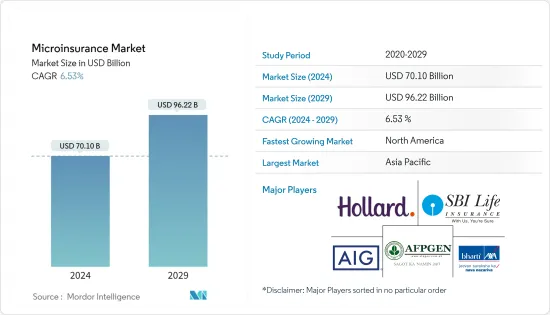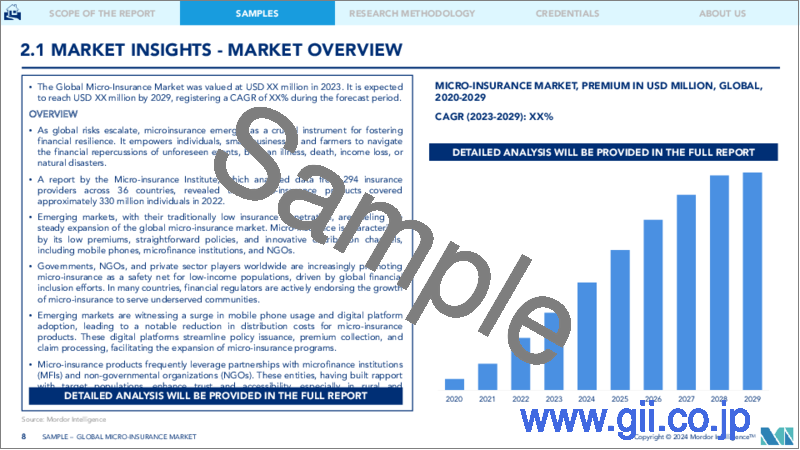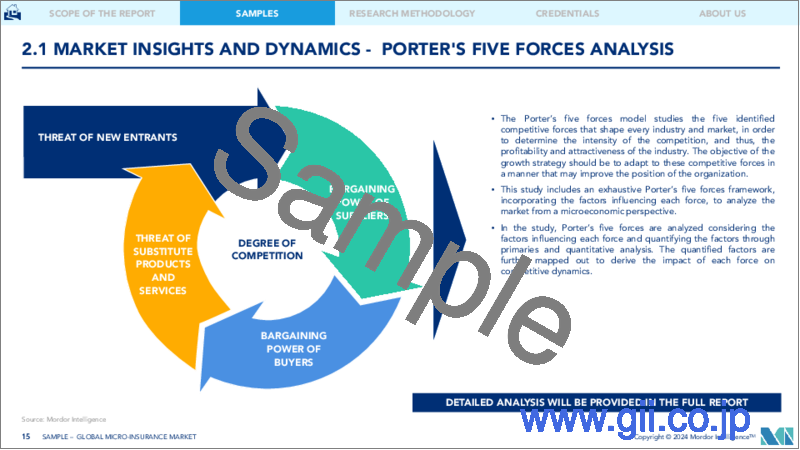|
|
市場調査レポート
商品コード
1521540
マイクロインシュアランス:市場シェア分析、産業動向と統計、成長予測(2024年~2029年)Microinsurance - Market Share Analysis, Industry Trends & Statistics, Growth Forecasts (2024 - 2029) |
||||||
カスタマイズ可能
適宜更新あり
|
|||||||
| マイクロインシュアランス:市場シェア分析、産業動向と統計、成長予測(2024年~2029年) |
|
出版日: 2024年07月15日
発行: Mordor Intelligence
ページ情報: 英文 120 Pages
納期: 2~3営業日
|
全表示
- 概要
- 目次
マイクロインシュアランスの市場規模は2024年に701億米ドルと推計され、2029年には962億2,000万米ドルに達し、予測期間(2024-2029年)のCAGRは6.53%で成長すると予測されます。

モバイル技術の有用性と費用対効果の世界の高まりにより、世界のマイクロインシュアランス市場に門戸が開かれました。低所得者層、新興市場、中小企業からの需要が高まる中、マイクロインシュアランス市場の拡大はテクノロジーと革新的な金融システムの活用にあります。この成長市場は、成長準備の整った企業にとって大きなチャンスです。
マイクロインシュアランスから生み出される収益は一貫して上昇を続けており、これはこれらの商品が世界的に受け入れられ、利用が拡大していることを示しています。この動向は、マイクロインシュアランスの選択肢の拡大、保険会社とマイクロファイナンス機関の協力体制、政府の規制などの要因によるものです。マイクロインシュアランスには、健康保険、生命保険、損害保険、農業保険、家畜保険など、幅広いリスクが含まれます。マイクロインシュアランスの需要は、十分なサービスを受けていない人々の経済的不安を軽減し、経済的回復力を促進する必要性から生じています。
マイクロインシュアランス・プロバイダーは、テクノロジー、持続可能性、イノベーションを活用して顧客サービスを向上させ、社会に積極的に貢献しています。COVID-19の流行は、マイクロインシュアランス・セクターにおけるデジタル変革の必要性を浮き彫りにし、デジタル販売チャネルへのシフトを加速させています。こうしたデジタル・プラットフォームにより、顧客は自宅から簡便に保険を購入できるようになり、対面でのやり取りが不要になります。また、デジタル・チャネルは、さまざまな顧客層のニーズに合わせてカスタマイズすることができ、よりパーソナライズされた体験を提供することができます。商業的に利用可能な市場は、商品の利用可能性を拡大する様々な動向に後押しされ、最近の急成長を遂げています。
マイクロインシュアランス市場の動向
低・中所得者はヘルスケア保険を好む
アフリカでは、医療マイクロ保険の販売業者は代理店やブローカーです。ラテンアメリカとカリブ海諸国では、金融機関が医療用マイクロインシュアランスの流通を支配しています。ある報告書によると、保険契約者の49%が女性であり、一方、医療マイクロインシュアランスの対象者の51%は女性です。
このセグメントの成長は、世界のヘルスケア費用の増加によるものです。ヘルスケア費用は世界中で増加しています。低所得者やその家族は、予期せぬ医療費によって経済的損失を被るリスクが高いです。ヘルスケア保険はこのリスクを軽減し、手頃な医療サービスを提供するのに役立ちます。
インドでは、国民健康保険制度(NHPS)が貧困家庭や恵まれない家庭に対する政府の主要な取り組みとして機能しています。この制度は、経済的に困窮している1億以上の世帯に保険適用を拡大することを目的としており、年間5,000万インドルピー(6,042.2米ドル)の保険金が提供されます。
アジア太平洋地域がマイクロインシュアランス市場を独占している
アジア太平洋地域は世界最大のマイクロインシュアランス市場のひとつであり、その主な要因は、発展途上国におけるマイクロインシュアランス商品・サービスに対する需要の高まりにあります。マイクロインシュアランスの普及は、経済的に恵まれない個人、デジタルに精通した若い世代、そしてマイクロインシュアランスの適用範囲を全国に広げることを目的とした政府の支援的なイニシアチブによる、ささやかな保険料の支払いによって推進されてきました。
需要の高まりは、低所得でサービスへのアクセスが限られている個人にとって、経済的で簡単に利用できる保険オプションへの要求が高まっていることによる。世界の金融情勢の変化に伴い、マイクロインシュアランスは格差を縮小し、金融包摂を進める上で極めて重要です。アジア太平洋地域は、マイクロインシュアランスの普及と金融リテラシーの向上において先陣を切っています。逆にアフリカは、革新的な販売方法、強固な規制構造、援助団体の支援により、成長のフロントランナーとして台頭してきています。
インドのPMSBYやPMJJBYのような政府の支援によるマイクロインシュアランスのイニシアチブは、リスクのある層に経済的保護を提供することに集中しています。カスタマイズされたマイクロインシュアランスの規制枠組みは、消費者福祉、明確な商品提供、そして市場環境の促進を提唱しています。
マイクロインシュアランス業界の概要
マイクロインシュアランス市場は細分化されています。また、マイクロインシュアランス・プロバイダーは、顧客のニーズを理解し、そのニーズを満たす商品を作るためにデータ分析を利用しています。機械学習アルゴリズムを使って顧客データを分析し、顧客のニーズを満たすリスクモデルを作成しています。大手企業は競争力を維持し、顧客に最先端のソリューションを提供するため、製品の発売、提携、M&Aなどの戦略的投資を行っています。市場を独占している主要企業は、ホラード・インシュアランス・カンパニー、afpgen.com.ph、アメリカン・インターナショナル・グループ・インク、バーティ・アクサ・ライフ・インシュアランス・カンパニー・リミテッドです。
その他の特典
- エクセル形式の市場予測(ME)シート
- 3ヶ月間のアナリスト・サポート
目次
第1章 イントロダクション
- 調査の前提条件と市場定義
- 調査範囲
第2章 調査手法
第3章 エグゼクティブサマリー
第4章 市場力学
- 市場概要
- 市場促進要因
- 金融サービスへのアクセス
- デジタルプラットフォームとモバイルテクノロジーの台頭
- 市場抑制要因
- データプライバシーとセキュリティへの懸念が市場成長を阻害
- 市場機会
- 新興諸国における保険加入義務に関する政府規制の強化
- 新興諸国における中間所得層の増加
- バリューチェーン/サプライチェーン分析
- 業界の魅力度ポーターのファイブフォース分析
- 新規参入業者の脅威
- 買い手/消費者の交渉力
- 供給企業の交渉力
- 代替品の脅威
- 競争企業間の敵対関係
- マイクロインシュアランス業界の動向とイノベーションに関する洞察
- COVID-19が市場に与える影響
第5章 市場セグメンテーション
- モデルタイプ別
- パートナー代理店モデル
- フルサービスモデル
- 製品タイプ別
- 生命保険
- 健康保険
- 損害保険
- その他の製品タイプ
- 販売チャネル別
- ダイレクト販売
- 金融機関
- デジタルチャネル
- その他の流通チャネル
- プロバイダー別
- 商業的実現可能
- 援助/政府支援
- 地域別
- 北米
- 欧州
- アジア太平洋
- 中東・アフリカ
- 南米
第6章 競合情勢
- 市場集中の概要
- 企業プロファイル
- 企業プロファイル
- The Hollard Insurance Company
- afpgen.com.ph
- American International Group Inc.
- Bharti AXA Life Insurance Company Limited
- SBI Life Insurance Company Limited
- ICICI Prudential Life Insurance Co. Ltd
- Banco do Nordeste Brasil SA
- Climbs
- Allianz SE
- Bajaj Allianz Life Insurance Co. Ltd*
第7章 市場機会と今後の動向
The Microinsurance Market size is estimated at USD 70.10 billion in 2024, and is expected to reach USD 96.22 billion by 2029, growing at a CAGR of 6.53% during the forecast period (2024-2029).

The growing utility and cost-effectiveness of mobile technology worldwide have opened the floodgates for the global microinsurance market. With increased demand from low-income individuals, emerging markets, and SMEs, the expansion of the microinsurance market lies in the use of technology and innovative financial systems. This growing market represents a significant opportunity for businesses prepared for growth.
The revenue generated from microinsurance is consistently rising, indicating a growing global embrace and utilization of these products. This trend is attributed to factors such as expanded microinsurance options, collaborative efforts between insurers and microfinance institutions, and governmental regulations. Microinsurance encompasses a wide range of risks, including health, life, property, agriculture, and livestock insurance. The demand for microinsurance stems from the necessity to mitigate financial insecurity among underserved populations and promote economic resilience.
Microinsurance providers are leveraging technology, sustainability, and innovation to enhance customer service and contribute positively to society. The COVID-19 pandemic has highlighted the necessity for digital transformation within the microinsurance sector, accelerating the shift toward digital distribution channels. These digital platforms enable customers to conveniently purchase insurance from their homes, eliminating face-to-face interaction requirements. Digital channels can also be customized to meet the needs of different customer segments, offering a more personalized experience. The commercially viable market has experienced rapid growth in recent years, driven by various developments that have expanded product availability.
Microinsurance Market Trends
Low- and Middle-income Earners prefer Healthcare Insurance
In Africa, health microinsurance distributors are agents and brokers. In Latin America and the Caribbean, financial institutions dominate the distribution of health microinsurance. According to a report, 49% of policyholders were women, whereas the female population constituted 51% of individuals covered by health microinsurance.
The segment's growth is due to the increasing cost of healthcare worldwide. Healthcare expenses are increasing all over the world. Low-income people and families are at a higher risk of financial loss due to unexpected medical costs. Health insurance helps to reduce this risk and provides affordable healthcare services.
In India, the National Health Protection Scheme (NHPS) serves as the government's primary initiative for impoverished and disadvantaged families. This program aims to extend coverage to more than 100 million economically challenged households, offering an annual sum of INR 5 lakhs (USD 6,042.2).
Asia-Pacific is Dominating the Microinsurance Market
Asia-Pacific is one of the largest microinsurance markets globally, primarily attributed to the increasing demand for microinsurance products and services in developing nations. The adoption of microinsurance has been propelled by modest premium payments from economically disadvantaged individuals, the digitally savvy younger generation, and supportive government initiatives aimed at broadening microinsurance coverage nationwide.
The rise in demand is driven by the growing requirement for economical and easily accessible insurance options for individuals with low incomes and limited access to services. With shifts occurring in the global financial arena, microinsurance is crucial in narrowing disparities and advancing financial inclusion. Asia-Pacific spearheads microinsurance adoption and financial literacy initiatives. Conversely, Africa is emerging as a frontrunner in growth due to innovative distribution methods, robust regulatory structures, and backing from aid organizations.
Government-backed microinsurance initiatives like the Indian PMSBY and PMJJBY concentrate on furnishing financial protection to at-risk demographics. Customized microinsurance regulatory frameworks advocate for consumer welfare, clear product offerings, and a conducive market atmosphere.
Microinsurance Industry Overview
The microinsurance market is fragmented. Microinsurance providers also use data analytics to understand the needs of their customers and create products that fulfill those needs. Machine learning algorithms are used to analyze customer data and create risk models to meet the needs of the customers. Leading companies are making strategic investments, including product launches, partnering, and M&A, to stay competitive and provide cutting-edge solutions to their clients. The major players dominating the market are The Hollard Insurance Company, afpgen.com.ph, American International Group Inc., and Bharti AXA Life Insurance Company Limited.
Additional Benefits:
- The market estimate (ME) sheet in Excel format
- 3 months of analyst support
TABLE OF CONTENTS
1 INTRODUCTION
- 1.1 Study Assumptions and Market Definition
- 1.2 Scope of the Study
2 RESEARCH METHODOLOGY
3 EXECUTIVE SUMMARY
4 MARKET DYNAMICS
- 4.1 Market Overview
- 4.2 Market Drivers
- 4.2.1 Access to Financial Services
- 4.2.2 Rise of Digital Platforms and Mobile Technology
- 4.3 Market Restraints
- 4.3.1 Data Privacy and Security Concerns Impeding Market Growth
- 4.4 Market Opportunities
- 4.4.1 Increasing Government Regulations on Mandatory Insurance Coverage in Developing Countries
- 4.4.2 Rise in the Middle-class Population in Developing Countries
- 4.5 Value Chain/Supply Chain Analysis
- 4.6 Industry Attractiveness: Porter's Five Forces Analysis
- 4.6.1 Threat of New Entrants
- 4.6.2 Bargaining Power of Buyers/Consumers
- 4.6.3 Bargaining Power of Suppliers
- 4.6.4 Threat of Substitutes
- 4.6.5 Intensity of Competitive Rivalry
- 4.7 Insights into Trends and Innovations in the Microinsurance Industry
- 4.8 Impact of COVID-19 on the Market
5 MARKET SEGMENTATION
- 5.1 By Model Type
- 5.1.1 Partner Agent Model
- 5.1.2 Full-service Model
- 5.2 By Product Type
- 5.2.1 Life Insurance
- 5.2.2 Health Insurance
- 5.2.3 Property Insurance
- 5.2.4 Other Product Types
- 5.3 By Distribution Channel
- 5.3.1 Direct Sales
- 5.3.2 Financial Institutions
- 5.3.3 Digital Channels
- 5.3.4 Other Distribution Channels
- 5.4 By Provider
- 5.4.1 Commercially Viable
- 5.4.2 Through Aid/Government Support
- 5.5 By Geography
- 5.5.1 North America
- 5.5.2 Europe
- 5.5.3 Asia-Pacific
- 5.5.4 Middle East and Africa
- 5.5.5 South America
6 COMPETITIVE LANDSCAPE
- 6.1 Market Concentration Overview
- 6.2 Company Profiles
- 6.3 Company Profiles
- 6.3.1 The Hollard Insurance Company
- 6.3.2 afpgen.com.ph
- 6.3.3 American International Group Inc.
- 6.3.4 Bharti AXA Life Insurance Company Limited
- 6.3.5 SBI Life Insurance Company Limited
- 6.3.6 ICICI Prudential Life Insurance Co. Ltd
- 6.3.7 Banco do Nordeste Brasil SA
- 6.3.8 Climbs
- 6.3.9 Allianz SE
- 6.3.10 Bajaj Allianz Life Insurance Co. Ltd*






